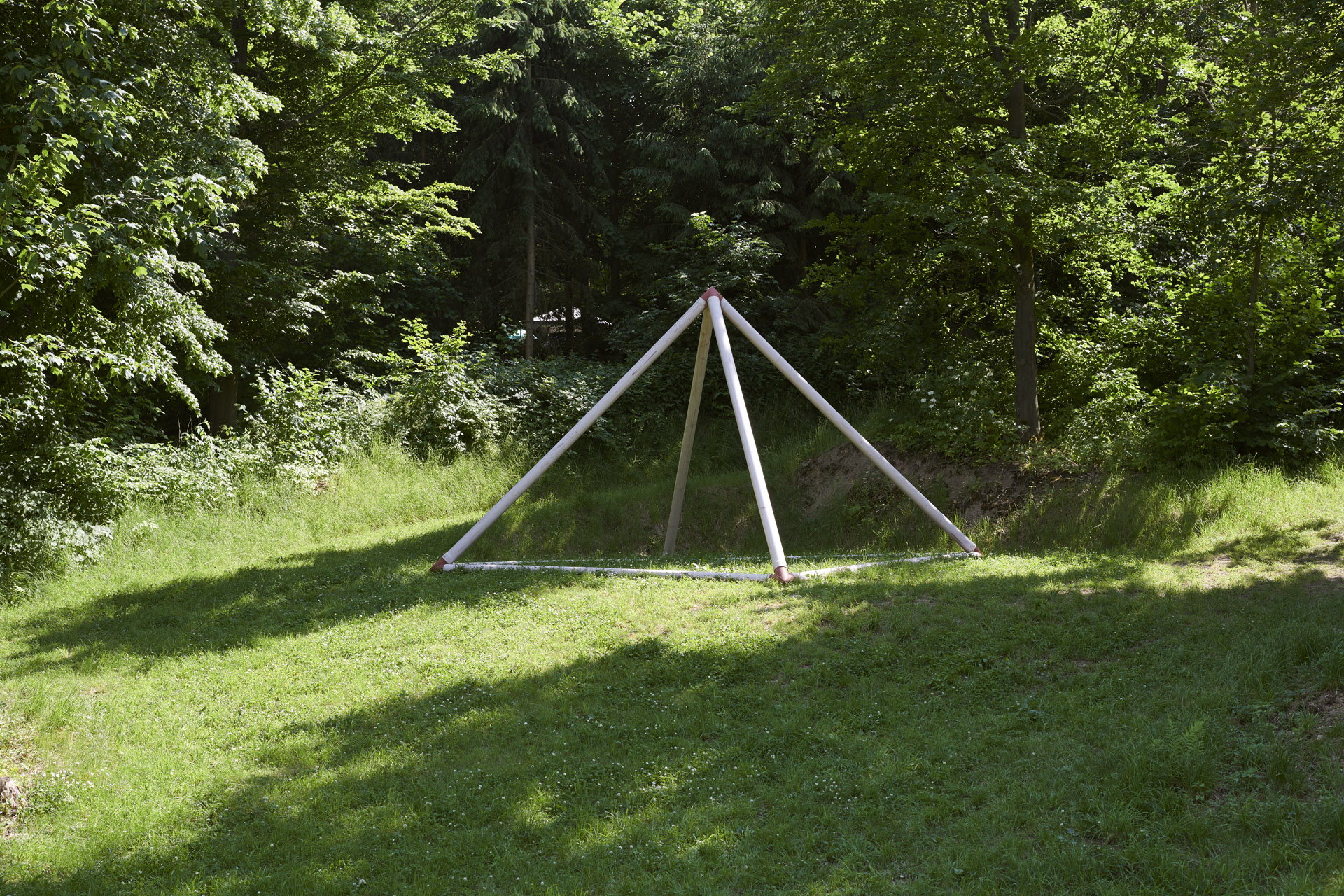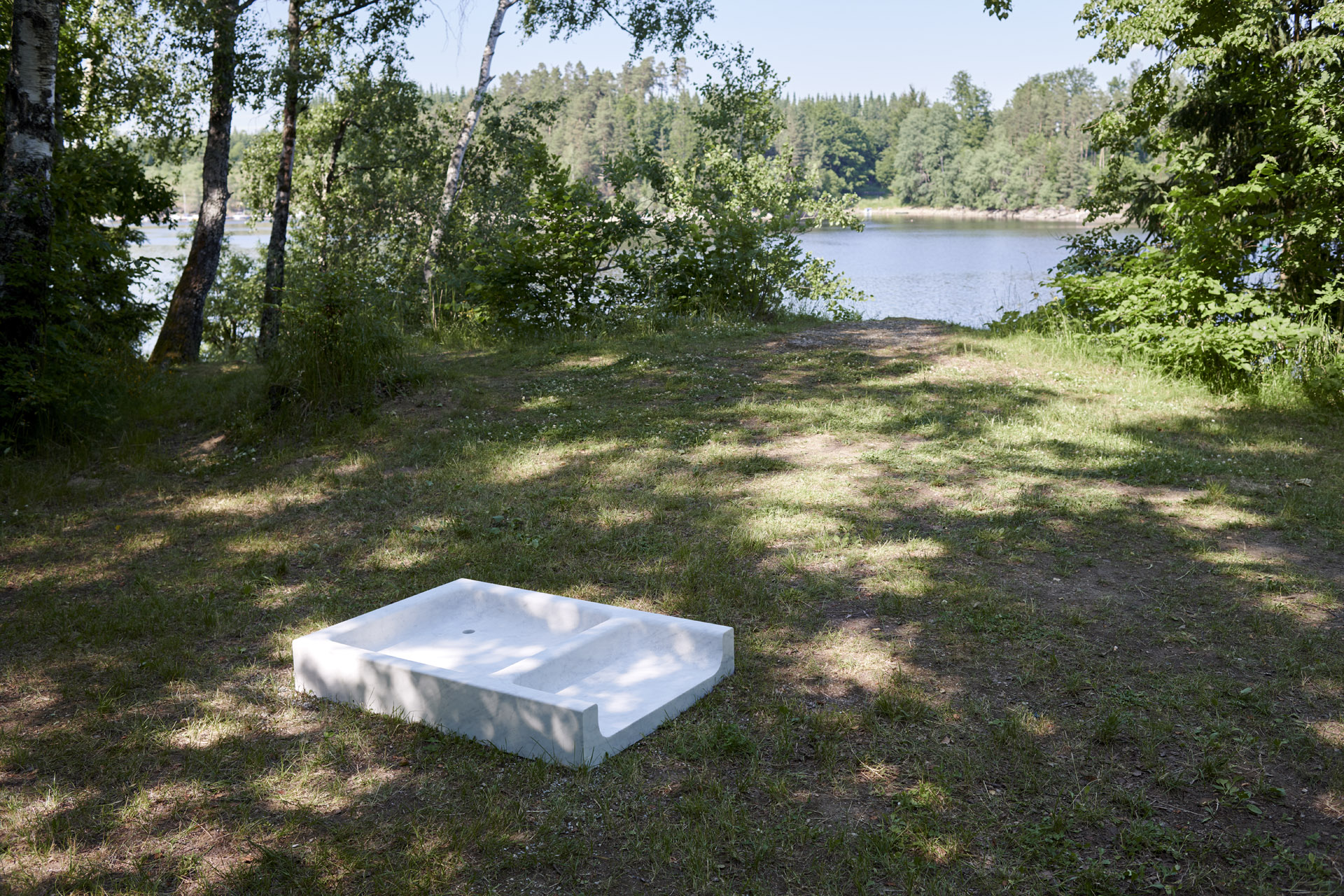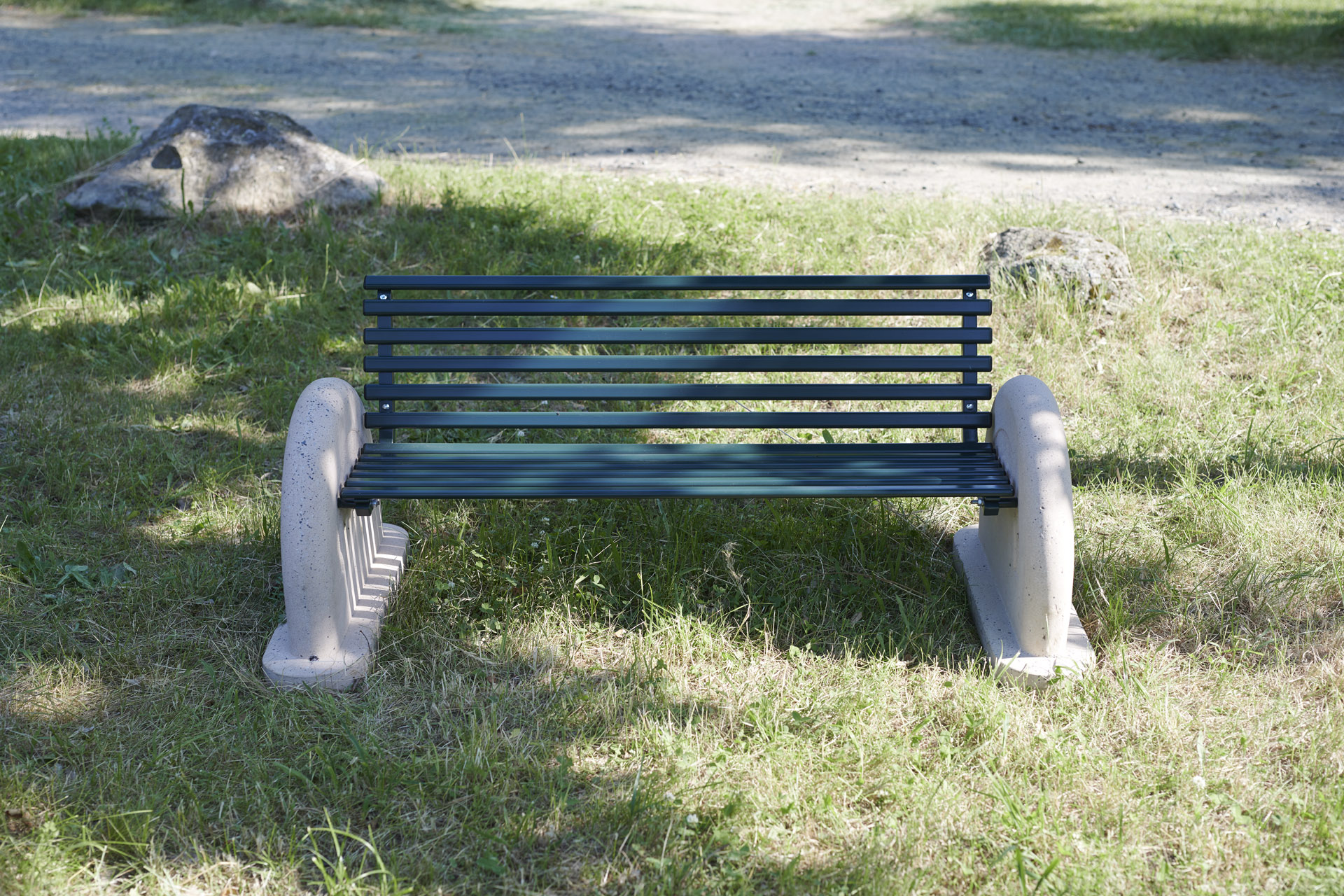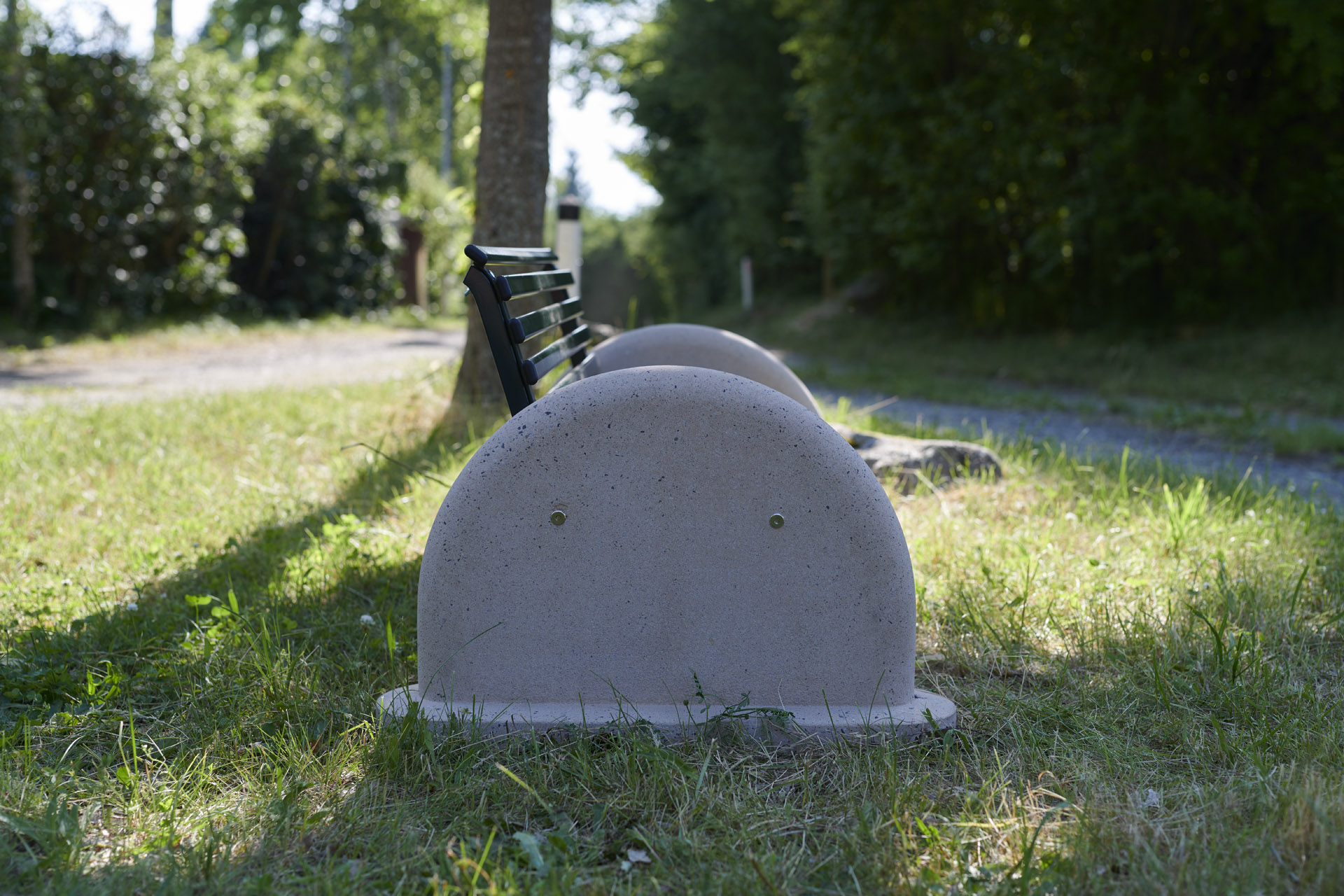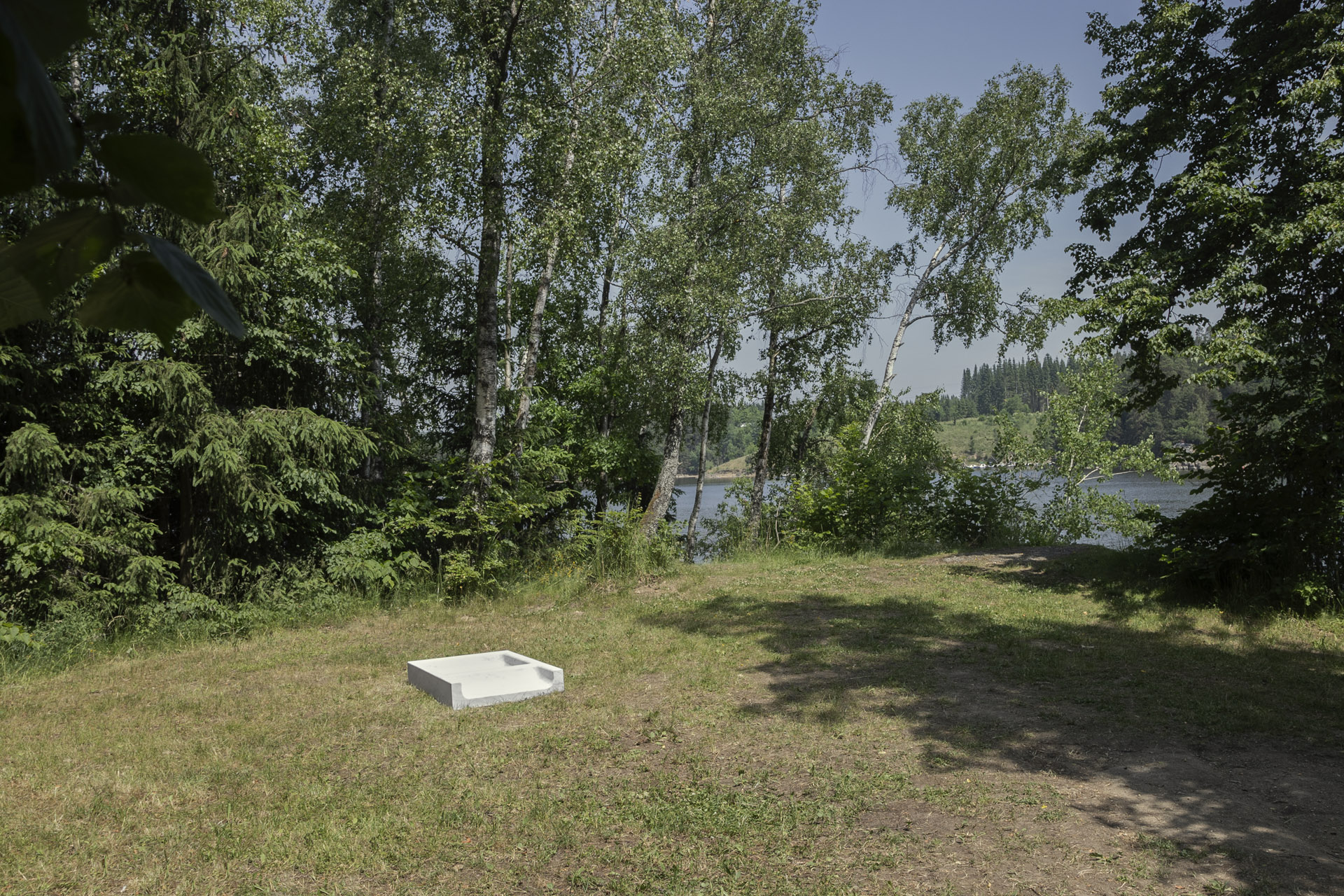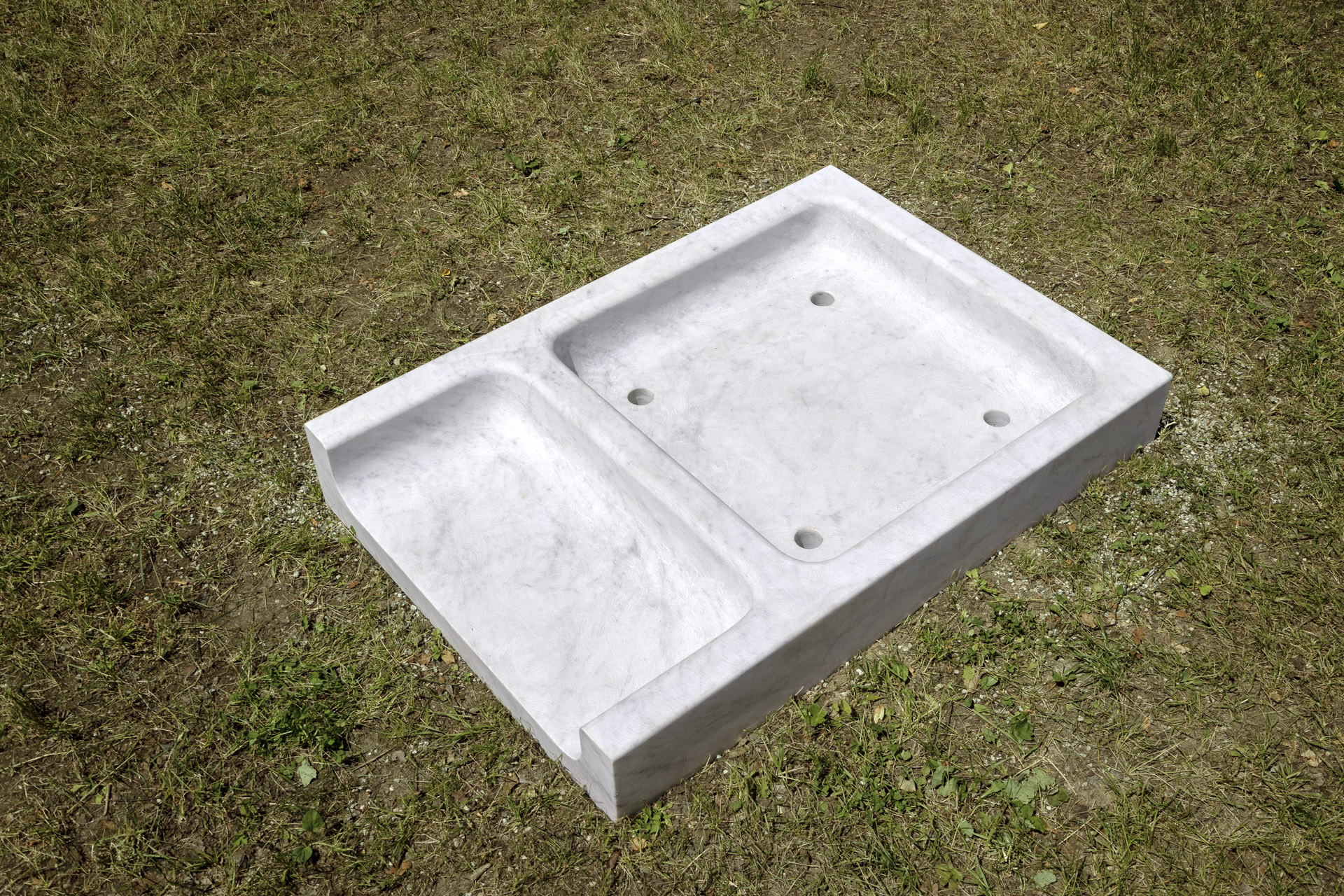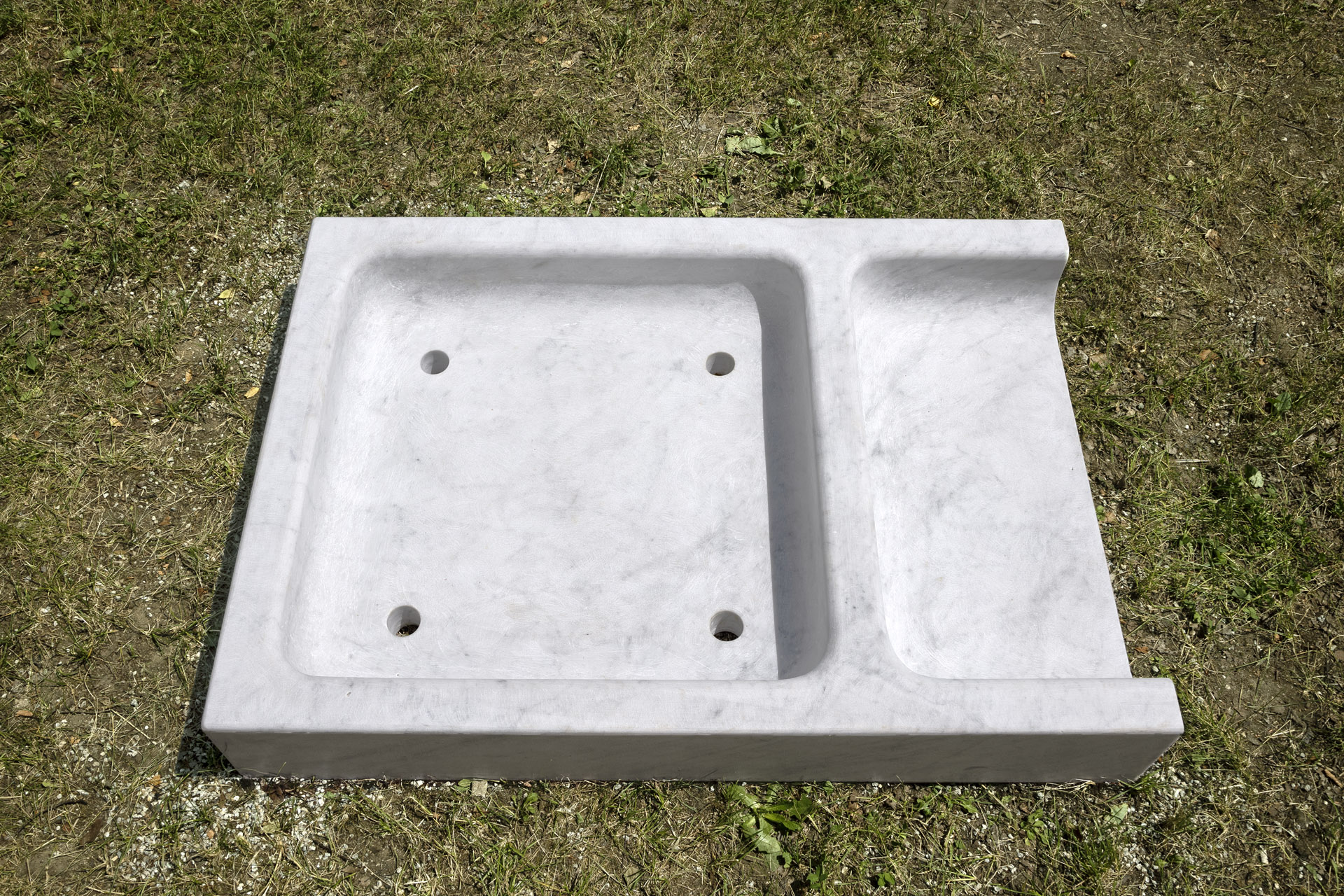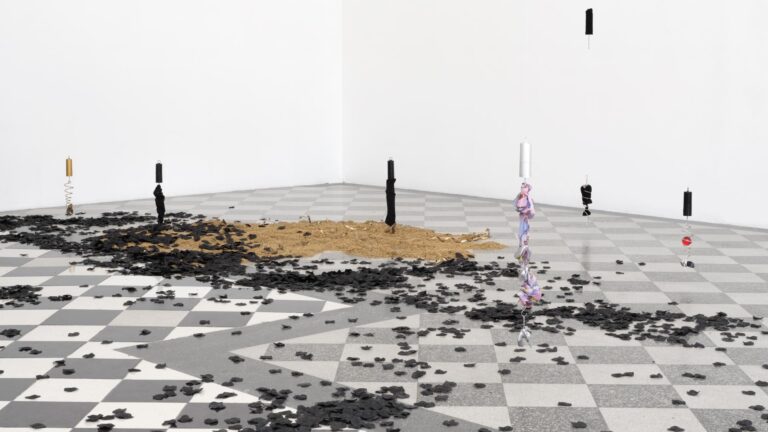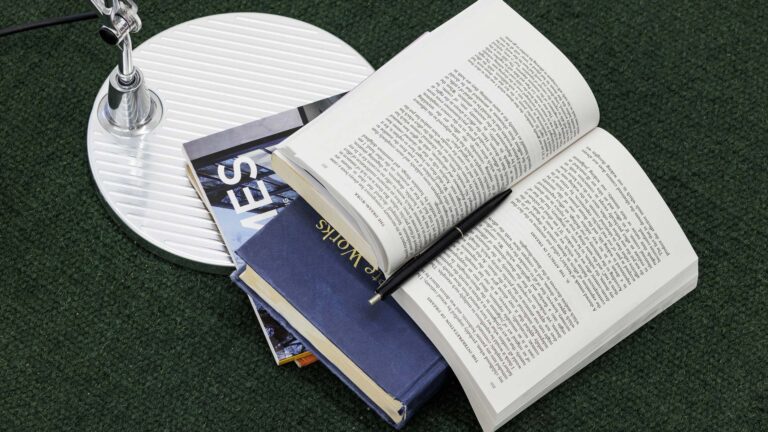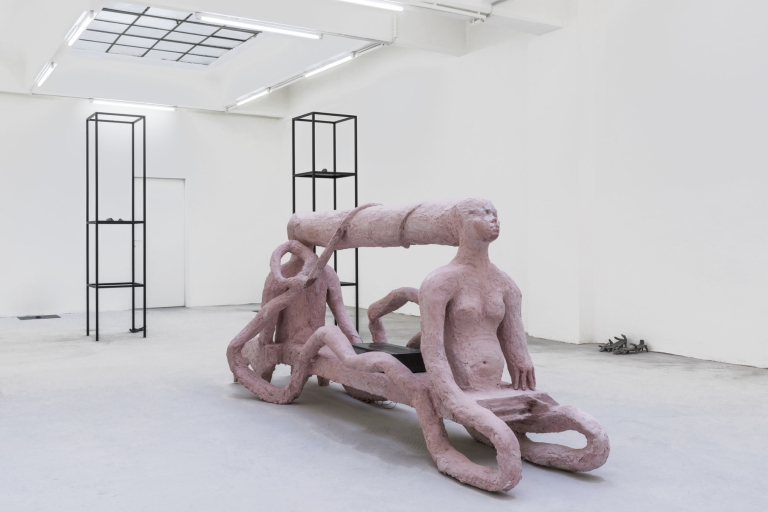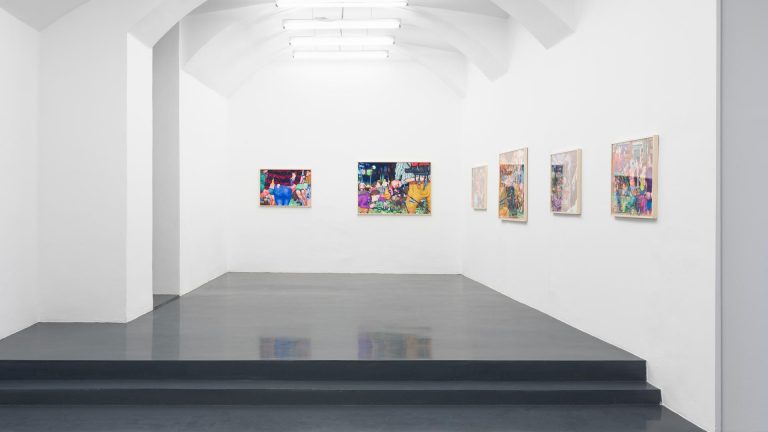Artists: Nina Beier, Stano Filko, Lena Henke, Benjamin Hirte, Yu Honglei, Dominique Knowles, Nancy Lupo, Heimo Zobernig
Exhibition title: Lichtenfels Sculpture
Curated by: Emanuel Layr and Olivia Thurn-Valsassina
Venue: Ottenstein Reservoir and the Lichtenfels Castle, Lichtenfels, Austria
Date: June 12 – October 17, 2021
Photography: all images copyright and courtesy of the artists and Lichtenfels Sculpture
This summer for the first time, sculptures by eight national and international artists will be on display along the Ottenstein reservoir and the Lichtenfels castle ruins. The exhibition, jointly curated by founder Olivia Thurn-Valsassina and Viennese gallerist Emanuel Layr, brings together artistic positions from a wide range of generations and geographical regions. Installed in the open air, each work develops its very own relation-ship to the nature and surroundings of the Austrian Waldviertel. The area of Lichtenfels Sculpture covers a total of three hectares and is open to all visitors free of charge from June 12 to October 17 2021.
Nancy Lupo
*1983 USA, lives and works in Los Angeles
Bench 2019, 2019
Terazzo, steel, powder-coated Pantone PMS 350U, bolts, plastic caps, chromed starscrews 56 × 139 × 66 cm
The different layers of interpretation a material can bear in diverse contexts play an essential role in Nancy Lupo‘s work. Therefor, she uses surfaces, colors, and shapes from existing objects, modifies them, and relocates them to another place where they often appear foreign or out of place.
Since 2015, Nancy Lupo has produced one bench a year, always referencing an already existing seating structure in a civic or commercial environment. The bench exhibited here, like all those in the series sca-led slightly smaller than its role model, refers to one located at the main train station in Rome. It reveals the artist‘s understanding of materiality as an onion of surfaces with shifting meanings, depending on where and by whom they are viewed or used.
Benjamin Hirte
*1980 Germany, lives and works in Vienna
The arcade tool, 2021
Carrara marble, 85 x 120 x 20 cm
In his work, Benjamin Hirte detaches standardized details from their architectural or linguistic contexts and transfers them into the exhibition space, where they function as signs referencing their social and political genesis.
The sculptural replica and duplication of a shower tray with four drains made of Carrara marble sits heavily on the flat, wooded plateau that juts out into the Ottenstein reservoir. Despite its transfer from private indoor to publicly accessible outdoor space, where it is exposed to the weather without connection to a sewer or shower spray, the tray retains its basic function: to collect and divert wastewater. The formal doubling lends the object, which sculpturally aligns with a minimalist tradition, a symbolic reading that refers to social con-flicts over access to basic infrastructures.
Nina Beier
*1975 Denmark, lives and works in Berlin and Copenhagen Guardian, 2020
Marble guardian lion, sand, 180 x 120 x 50 cm
Contrasts and ruptures characterize Nina Beier’s work. The artist digs into cultural codes to find things that are loaded with particularly problematic and layered stories, things that have undergone a transformation in terms of their intention, production, distribution, trading and use. Especially those objects that represent collapsed systems are autopsied by the artist, exposing the implicit economical and interpersonal power structures they perform.
The marble lion sculpture, partially buried under the sand of the narrow beach, is the product of a long and extensive cultural history. It has traveled over the millennia from Greece to India to China and on to Italy, changing along the way, both in form and meaning. In one place, lions represent protection, in another, power and prestige. Today, the lion is primarily a symbol of globalization, as most of its kind are produced in China. Beier‘s manipulations, simple at first glance, show the opposing structures and the complexity of the things we surround ourselves with.
Lena Henke
*1982 Germany, lives and works in New York and Berlin Las Pozas, 2017
Aluminum, 160 x 248 x 140 cm, 160 x 278 x 148 cm
In her work, Lena Henke investigates the conditions and possibilities of sculpture and explores the limits of materials and forms. Her focus lies primarily on questions of social and architectural power relations in urban space.
Two oval-shaped, 160 cm high sculptures made from aluminum are positioned at the center of the ruins of Lichtenfels Castle. Panoramic mirrors are installed on the trees and walls above them, helping the viewer to make out the inner shape of the works. Anyone who looks into them, in turn meets the gaze of two big eyes. The works bear witness to Henke‘s preoccupation with sculpture gardens as large-scale projects by individual, mostly male artists. Their title is borrowed from the sculptural-architectural Gesamtkunst-werk by Edward James and Plutarco Gastélum, which they built in the Mexican jungle between 1962 and 1982. However, while their work blends in gently with the nature on site, Henke‘s aluminum eyes confid-ently stand in the way here, challenging viewers to a gaze duel and thus making them aware of their own physical presence.
Yu Honglei
*1984 China, lives and works in Beijing
#4, 2018
Brass, steel, iron wire, paper, millet, rice, 117 x 53 x 64 cm
Yu Honglei‘s sculptures take shape in a variety of media and materials. The ephemeral nature of the objects and images surrounding us plays an essential role in his work, which poetically combines manifold personal experiences and everyday impressions from urban China.
In the chapel of the Lichtenfels castle ruins, a sculpture that appears at once clumsy and fragile stands on a small pedestal. In addition to the classic sculptural materials of brass and steel, Yu Honglei used paper, millet and rice. Here, the surface and rough texture of the brass gives the impression of primitive rawness, while the shape of the sculpture is reminiscent of a charming emoji with chili peppers rising like smoke through a small pipe. Through these contrasts, the artist explores the effectiveness of the visual on our em-bodied reality.
Dominique Knowles
*1996 Bahamas, lives and works in Chicago
Ode to Tazz, 2021
Green Granite, 89 x 58,5 x 10 cm
Artist and poet Dominique Knowles‘ work illustrates the ancient bond and complex intimacy between hu-mans and animals. The horse thereby takes center stage, often recurring in his pictorial work reminiscent of cave painting as well as his poems and video works.
A poem carved in granite stone commemorates Tazz, the artist‘s deceased horse. The two, like many horses and riders, shared a close physical as well as mental bond. The gestures and movements that characterize this relationship are part of a kind of physical memory, which the artist recalls in his works in both gestural and linguistic ways. The sculpture, positioned on the headland behind the ruins of Lichtenfels Castle, reminds of a gravestone or cenotaph and thus stands for the commemoration, but also veneration of the animal partner.
Stano Filko
*1937 Czechoslovakia – 2015 Slovakia
Pyramid, 1995
Plastic tubes, paint, ca. 550 x 550 x 550 cm
Stano Filko was a key figure of the Czechoslovak neo-avant-garde. His oeuvre is based on a personal, all-encompassing cosmology, which he started to develop in the 1970s. When he died in 2015, Filko left behind a complex body of work based on six cosmological dimensions and eighteen chakras that are distinct in content and color.
The pyramid visualizes the connection of the 3rd, 4th and 5th dimension in Filko‘s cosmology. They repre-sent the four elements, pure time and the nirvana. Over the course of his life, Filko created dozens of pyr-amids from a wide variety of materials, with the triangle becoming a symbol of his identity and the pyramid thus a kind of self-portrait.
Heimo Zobernig
*1958 Austria, lives and works in Vienna
Untitled, 2017
Bronze, 185 x 65 x 41 cm
Sculpture, along with painting, film, performance, and design, is the central component of Heimo Zobernig‘s cross-media art. In his works and spatial interventions, he examines the institutional and architectural frame-work of the art world and puts language, object, image, material, form and presentation into a multi-layered context.
At the furthest point of the Lichtenfels Sculpture site, a rocky outcrop, stands Heimo Zobernig‘s bronze. It shows a male figure that instead of standing on a pedestal is partly positioned within it. Zobernig has been experimenting with readymade mannequins for many years and in 2015 began working in bronze while combining male and female components and casting them together with his own facial imprint. However, instead of cutting the casting channels flush and sanding the welds, the artist deliberately leaves the marks of production visible. Thereby the sculpture inevitably points to the fragility of human existence.
Nina Beier, Guardian, 2020, Marble guardian lion, sand, 180 x 120 x 50 cm. Courtesy: the artist, Croy Nielsen Vienna, Installation view, Lichtenfels Sculpture 2021, Photo: Maximilian Anelli-Monti
Nina Beier, Guardian, 2020, Marble guardian lion, sand, 180 x 120 x 50 cm. Courtesy: the artist, Croy Nielsen Vienna, Installation view, Lichtenfels Sculpture 2021, Photo: Maximilian Anelli-Monti
Nina Beier, Guardian, 2020, Marble guardian lion, sand, 180 x 120 x 50 cm. Courtesy: the artist, Croy Nielsen Vienna, Installation view, Lichtenfels Sculpture 2021, Photo: Maximilian Anelli-Monti
Nina Beier, Guardian, 2020, Marble guardian lion, sand, 180 x 120 x 50 cm. Courtesy: the artist, Croy Nielsen Vienna, Installation view, Lichtenfels Sculpture 2021, Photo: Maximilian Anelli-Monti
Nina Beier, Guardian, 2020, Marble guardian lion, sand, 180 x 120 x 50 cm. Courtesy: the artist, Croy Nielsen Vienna, Installation view, Lichtenfels Sculpture 2021, Photo: Maximilian Anelli-Monti
Nina Beier, Guardian, 2020, Marble guardian lion, sand, 180 x 120 x 50 cm. Courtesy: the artist, Croy Nielsen Vienna, Installation view, Lichtenfels Sculpture 2021, Photo: Maximilian Anelli-Monti
Nina Beier, Guardian, 2020, Marble guardian lion, sand, 180 x 120 x 50 cm. Courtesy: the artist, Croy Nielsen Vienna, Installation view, Lichtenfels Sculpture 2021, Photo: Maximilian Anelli-Monti
Nina Beier, Guardian, 2020, Marble guardian lion, sand, 180 x 120 x 50 cm. Courtesy: the artist, Croy Nielsen Vienna, Installation view, Lichtenfels Sculpture 2021, Photo: Maximilian Anelli-Monti
Lena Henke, Las Pozas, 2017, Aluminium, 160 x 248 x 140 cm, 160 x 278 x 148 cm. Courtesy: the artist, LAYR Vienna, Installation view, Lichtenfels Sculpture 2021, Photo: Maximilian Anelli-Monti
Lena Henke, Las Pozas, 2017, Aluminium, 160 x 248 x 140 cm, 160 x 278 x 148 cm. Courtesy: the artist, LAYR Vienna, Installation view, Lichtenfels Sculpture 2021, Photo: Maximilian Anelli-Monti
Lena Henke, Las Pozas, 2017, Aluminium, 160 x 248 x 140 cm, 160 x 278 x 148 cm. Courtesy: the artist, LAYR Vienna, Installation view, Lichtenfels Sculpture 2021, Photo: Maximilian Anelli-Monti
Lena Henke, Las Pozas, 2017, Aluminium, 160 x 248 x 140 cm, 160 x 278 x 148 cm. Courtesy: the artist, LAYR Vienna, Installation view, Lichtenfels Sculpture 2021, Photo: Maximilian Anelli-Monti
Yu Honglei, #4, 2018, Brass, steel, iron wire, paper, millet, rice, 117 x 53 x 64 cm. Courtesy the artist; Kraupa-Tuskany Zeidler, Berlin, Installation view, Lichtenfels Sculpture 2021, Photo: Maximilian Anelli-Monti
Yu Honglei, #4, 2018, Brass, steel, iron wire, paper, millet, rice, 117 x 53 x 64 cm. Courtesy the artist; Kraupa-Tuskany Zeidler, Berlin, Installation view, Lichtenfels Sculpture 2021, Photo: Maximilian Anelli-Monti
Yu Honglei, #4, 2018, Brass, steel, iron wire, paper, millet, rice, 117 x 53 x 64 cm. Courtesy the artist; Kraupa-Tuskany Zeidler, Berlin, Installation view, Lichtenfels Sculpture 2021, Photo: Maximilian Anelli-Monti
Yu Honglei, #4, 2018, Brass, steel, iron wire, paper, millet, rice, 117 x 53 x 64 cm. Courtesy the artist; Kraupa-Tuskany Zeidler, Berlin, Installation view, Lichtenfels Sculpture 2021, Photo: Maximilian Anelli-Monti
Yu Honglei, #4, 2018, Brass, steel, iron wire, paper, millet, rice, 117 x 53 x 64 cm. Courtesy the artist; Kraupa-Tuskany Zeidler, Berlin, Installation view, Lichtenfels Sculpture 2021, Photo: Maximilian Anelli-Monti
Yu Honglei, #4, 2018, Brass, steel, iron wire, paper, millet, rice, 117 x 53 x 64 cm. Courtesy the artist; Kraupa-Tuskany Zeidler, Berlin, Installation view, Lichtenfels Sculpture 2021, Photo: Maximilian Anelli-Monti
Yu Honglei, #4, 2018, Brass, steel, iron wire, paper, millet, rice, 117 x 53 x 64 cm. Courtesy the artist; Kraupa-Tuskany Zeidler, Berlin, Installation view, Lichtenfels Sculpture 2021, Photo: Maximilian Anelli-Monti
Yu Honglei, #4, 2018, Brass, steel, iron wire, paper, millet, rice, 117 x 53 x 64 cm. Courtesy the artist; Kraupa-Tuskany Zeidler, Berlin, Installation view, Lichtenfels Sculpture 2021, Photo: Maximilian Anelli-Monti
Lena Henke, Las Pozas, 2017, Aluminium, 160 x 248 x 140 cm, 160 x 278 x 148 cm. Courtesy: the artist, LAYR Vienna, Installation view, Lichtenfels Sculpture 2021, Photo: Maximilian Anelli-Monti
Dominique Knowles, Ode to Tazz, 2021, Green Granite, 89 x 58,5 x 10 cm. Courtesy: the artist, Installation view, Lichtenfels Sculpture 2021, Photo: Maximilian Anelli-Monti
Dominique Knowles, Ode to Tazz, 2021, Green Granite, 89 x 58,5 x 10 cm. Courtesy: the artist, Installation view, Lichtenfels Sculpture 2021, Photo: Maximilian Anelli-Monti
Dominique Knowles, Ode to Tazz, 2021, Green Granite, 89 x 58,5 x 10 cm. Courtesy: the artist, Installation view, Lichtenfels Sculpture 2021, Photo: Maximilian Anelli-Monti
Dominique Knowles, Ode to Tazz, 2021, Green Granite, 89 x 58,5 x 10 cm. Courtesy: the artist, Installation view, Lichtenfels Sculpture 2021, Photo: Maximilian Anelli-Monti
Dominique Knowles, Ode to Tazz, 2021, Green Granite, 89 x 58,5 x 10 cm. Courtesy: the artist, Installation view, Lichtenfels Sculpture 2021, Photo: Maximilian Anelli-Monti
Dominique Knowles, Ode to Tazz, 2021, Green Granite, 89 x 58,5 x 10 cm. Courtesy: the artist, Installation view, Lichtenfels Sculpture 2021, Photo: Maximilian Anelli-Monti
Dominique Knowles, Ode to Tazz, 2021, Green Granite, 89 x 58,5 x 10 cm. Courtesy: the artist, Installation view, Lichtenfels Sculpture 2021, Photo: Maximilian Anelli-Monti
Heimo Zobernig, Untitled, 2017 Bronze, 185 x 65 x 41 cm. Courtesy: Heimo Zobernig, Installation view, Lichtenfels Sculpture 2021, Photo: Maximilian Anelli-Monti
Heimo Zobernig, Untitled, 2017 Bronze, 185 x 65 x 41 cm. Courtesy: Heimo Zobernig, Installation view, Lichtenfels Sculpture 2021, Photo: Maximilian Anelli-Monti
Heimo Zobernig, Untitled, 2017 Bronze, 185 x 65 x 41 cm. Courtesy: Heimo Zobernig, Installation view, Lichtenfels Sculpture 2021, Photo: Maximilian Anelli-Monti
Heimo Zobernig, Untitled, 2017 Bronze, 185 x 65 x 41 cm. Courtesy: Heimo Zobernig, Installation view, Lichtenfels Sculpture 2021, Photo: Maximilian Anelli-Monti
çHeimo Zobernig, Untitled, 2017 Bronze, 185 x 65 x 41 cm. Courtesy: Heimo Zobernig, Installation view, Lichtenfels Sculpture 2021, Photo: Maximilian Anelli-Monti
Heimo Zobernig, Untitled, 2017 Bronze, 185 x 65 x 41 cm. Courtesy: Heimo Zobernig, Installation view, Lichtenfels Sculpture 2021, Photo: Maximilian Anelli-Monti
Stano Filko, Pyramid, 1995, Plastic tubes, paint, ca, 550 x 550 x 550 cm. Courtesy: the artist, Linea Bratislava, LAYR Vienna, Installation view, Lichtenfels Sculpture 2021, Photo: Maximilian Anelli-Monti
Stano Filko, Pyramid, 1995, Plastic tubes, paint, ca, 550 x 550 x 550 cm. Courtesy: the artist, Linea Bratislava, LAYR Vienna, Installation view, Lichtenfels Sculpture 2021, Photo: Maximilian Anelli-Monti
Stano Filko, Pyramid, 1995, Plastic tubes, paint, ca, 550 x 550 x 550 cm. Courtesy: the artist, Linea Bratislava, LAYR Vienna, Installation view, Lichtenfels Sculpture 2021, Photo: Maximilian Anelli-Monti
Stano Filko, Pyramid, 1995, Plastic tubes, paint, ca, 550 x 550 x 550 cm. Courtesy: the artist, Linea Bratislava, LAYR Vienna, Installation view, Lichtenfels Sculpture 2021, Photo: Maximilian Anelli-Monti
Stano Filko, Pyramid, 1995, Plastic tubes, paint, ca, 550 x 550 x 550 cm. Courtesy: the artist, Linea Bratislava, LAYR Vienna, Installation view, Lichtenfels Sculpture 2021, Photo: Maximilian Anelli-Monti
Nancy Lupo, Bench 2019, 2019, Terazzo, steel, powder-coated Pantone PMS 350U, bolts, plastic caps, chromed starscrews 56 × 139 × 66 cm. Courtesy: the artist, Jan Kaps, Cologne, Installation view, Lichtenfels Sculpture 2021, Photo: Maximilian Anelli-Monti
Nancy Lupo, Bench 2019, 2019, Terazzo, steel, powder-coated Pantone PMS 350U, bolts, plastic caps, chromed starscrews 56 × 139 × 66 cm. Courtesy: the artist, Jan Kaps, Cologne, Installation view, Lichtenfels Sculpture 2021, Photo: Maximilian Anelli-Monti
Benjamin Hirte, The arcade tool, 2021, Carrara marble, 85 x 120 x 20 cm. Courtesy: the artist, LAYR Vienna, Installation view, Lichtenfels Sculpture 2021, Photo: Benedikt von Loebell
Nancy Lupo, Bench 2019, 2019, Terazzo, steel, powder-coated Pantone PMS 350U, bolts, plastic caps, chromed starscrews 56 × 139 × 66 cm. Courtesy: the artist, Jan Kaps, Cologne, Installation view, Lichtenfels Sculpture 2021, Photo: Maximilian Anelli-Monti
Nancy Lupo, Bench 2019, 2019, Terazzo, steel, powder-coated Pantone PMS 350U, bolts, plastic caps, chromed starscrews 56 × 139 × 66 cm. Courtesy: the artist, Jan Kaps, Cologne, Installation view, Lichtenfels Sculpture 2021, Photo: Maximilian Anelli-Monti
Nancy Lupo, Bench 2019, 2019, Terazzo, steel, powder-coated Pantone PMS 350U, bolts, plastic caps, chromed starscrews 56 × 139 × 66 cm. Courtesy: the artist, Jan Kaps, Cologne, Installation view, Lichtenfels Sculpture 2021, Photo: Maximilian Anelli-Monti
Nancy Lupo, Bench 2019, 2019, Terazzo, steel, powder-coated Pantone PMS 350U, bolts, plastic caps, chromed starscrews 56 × 139 × 66 cm. Courtesy: the artist, Jan Kaps, Cologne, Installation view, Lichtenfels Sculpture 2021, Photo: Maximilian Anelli-Monti
Nancy Lupo, Bench 2019, 2019, Terazzo, steel, powder-coated Pantone PMS 350U, bolts, plastic caps, chromed starscrews 56 × 139 × 66 cm. Courtesy: the artist, Jan Kaps, Cologne, Installation view, Lichtenfels Sculpture 2021, Photo: Maximilian Anelli-Monti
Nancy Lupo, Bench 2019, 2019, Terazzo, steel, powder-coated Pantone PMS 350U, bolts, plastic caps, chromed starscrews 56 × 139 × 66 cm. Courtesy: the artist, Jan Kaps, Cologne, Installation view, Lichtenfels Sculpture 2021, Photo: Maximilian Anelli-Monti
Benjamin Hirte, The arcade tool, 2021, Carrara marble, 85 x 120 x 20 cm. Courtesy: the artist, LAYR Vienna, Installation view, Lichtenfels Sculpture 2021, Photo: Benedikt von Loebell
Benjamin Hirte, The arcade tool, 2021, Carrara marble, 85 x 120 x 20 cm. Courtesy: the artist, LAYR Vienna, Installation view, Lichtenfels Sculpture 2021, Photo: Benedikt von Loebell
Benjamin Hirte, The arcade tool, 2021, Carrara marble, 85 x 120 x 20 cm. Courtesy: the artist, LAYR Vienna, Installation view, Lichtenfels Sculpture 2021, Photo: Benedikt von Loebell
Benjamin Hirte, The arcade tool, 2021, Carrara marble, 85 x 120 x 20 cm. Courtesy: the artist, LAYR Vienna, Installation view, Lichtenfels Sculpture 2021, Photo: Benedikt von Loebell
Benjamin Hirte, The arcade tool, 2021, Carrara marble, 85 x 120 x 20 cm. Courtesy: the artist, LAYR Vienna, Installation view, Lichtenfels Sculpture 2021, Photo: Benedikt von Loebell
Benjamin Hirte, The arcade tool, 2021, Carrara marble, 85 x 120 x 20 cm. Courtesy: the artist, LAYR Vienna, Installation view, Lichtenfels Sculpture 2021, Photo: Benedikt von Loebell
Benjamin Hirte, The arcade tool, 2021, Carrara marble, 85 x 120 x 20 cm. Courtesy: the artist, LAYR Vienna, Installation view, Lichtenfels Sculpture 2021, Photo: Benedikt von Loebell
Benjamin Hirte, The arcade tool, 2021, Carrara marble, 85 x 120 x 20 cm. Courtesy: the artist, LAYR Vienna, Installation view, Lichtenfels Sculpture 2021, Photo: Benedikt von Loebell




































